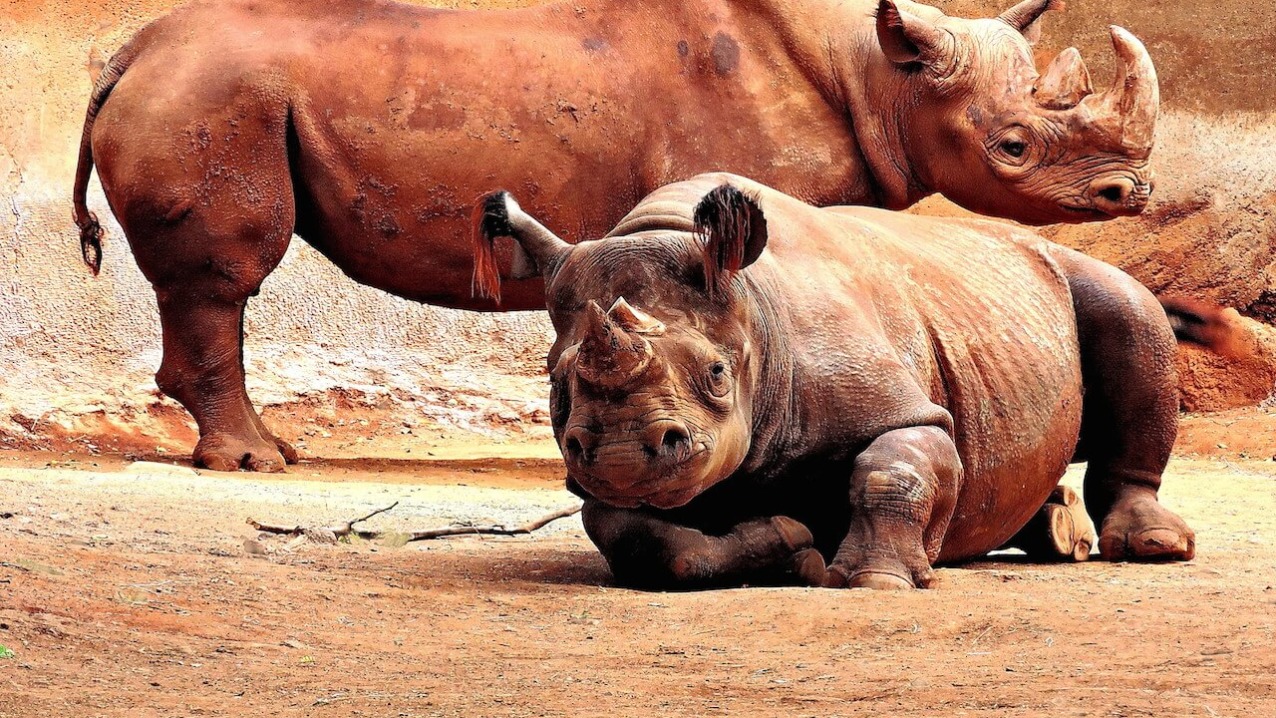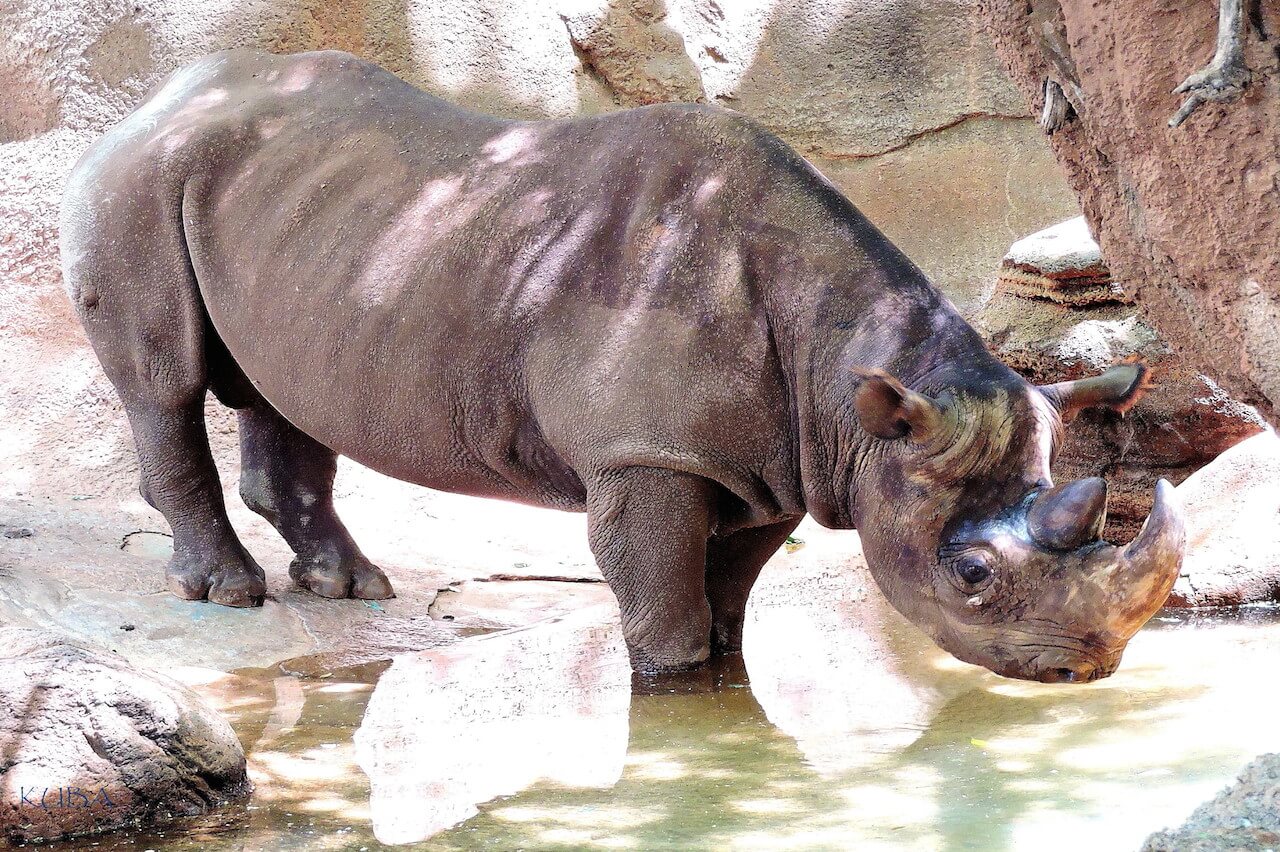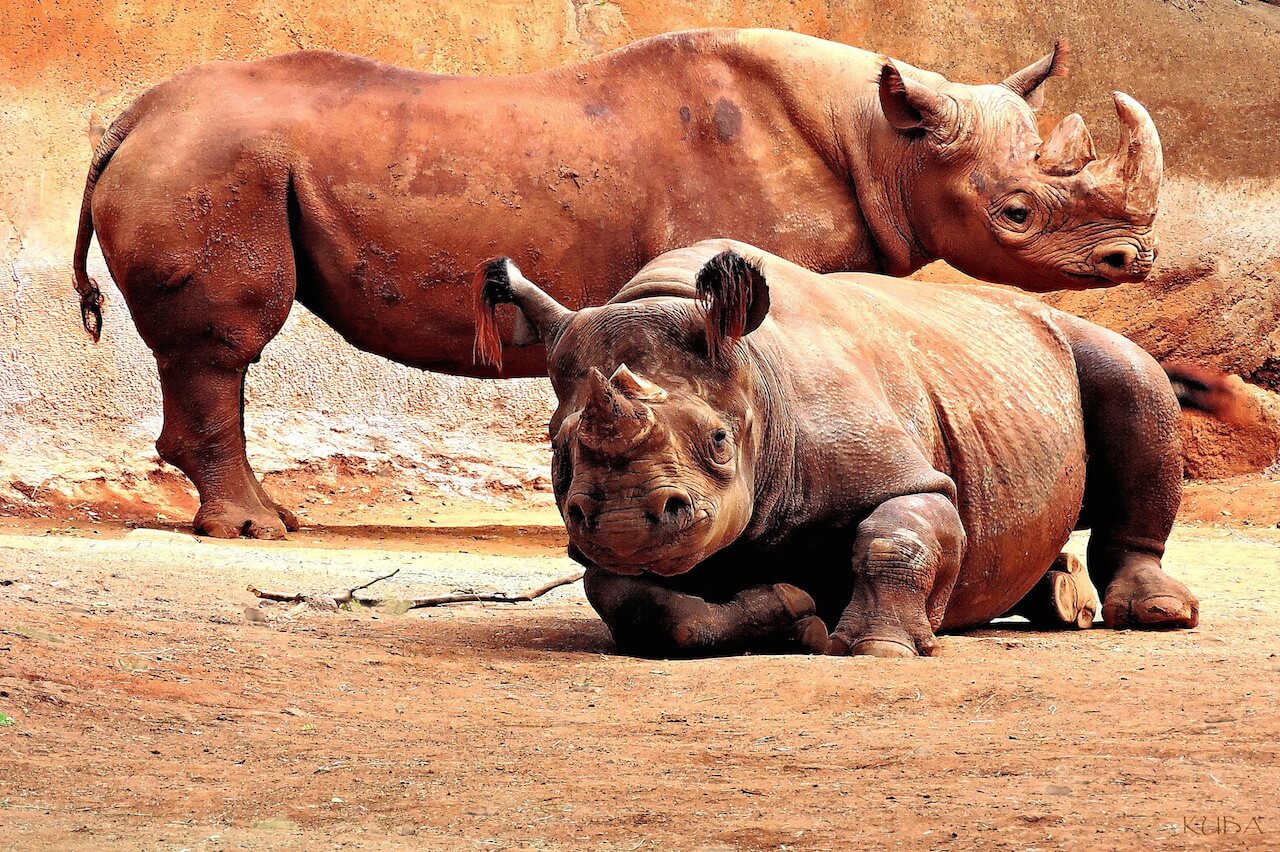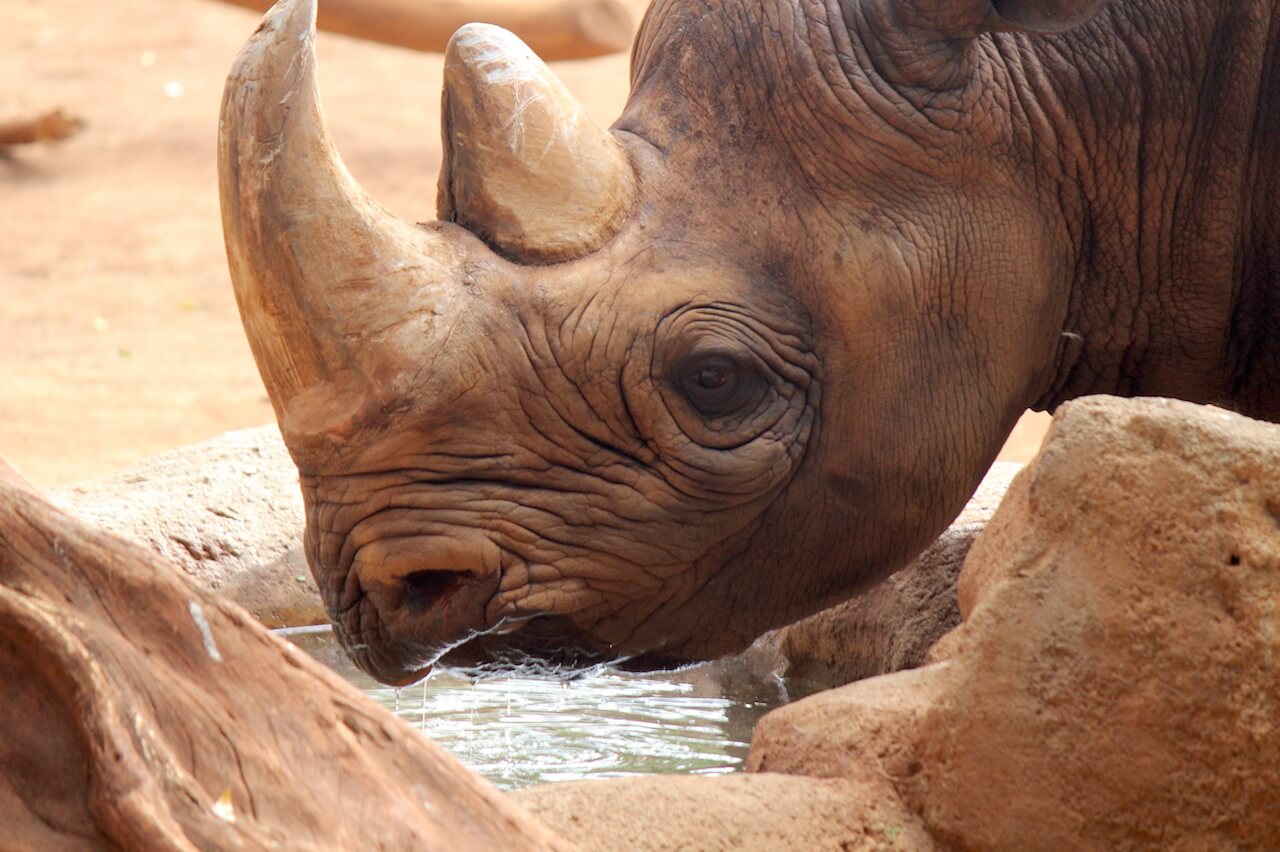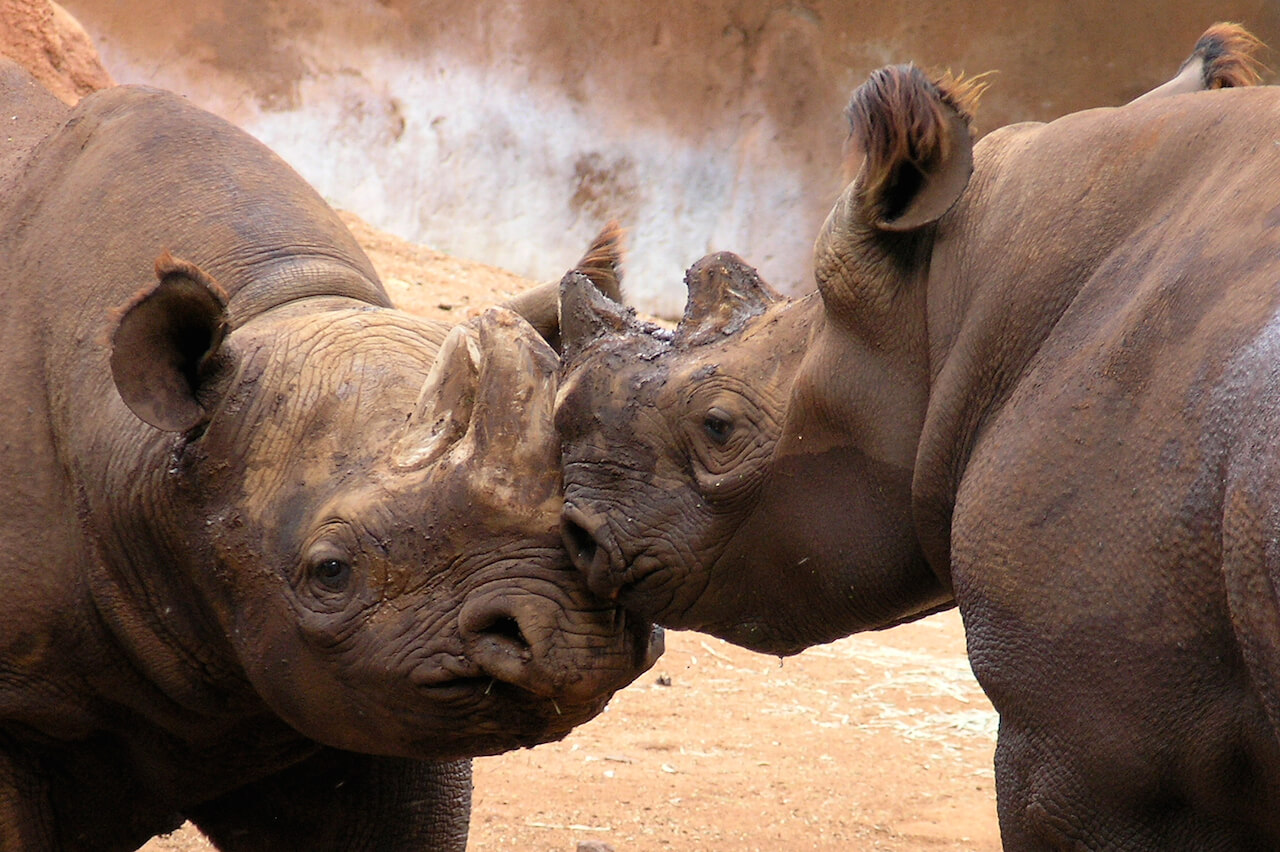diceros bicornis
Black Rhinoceros
About Me
Scientific Name: Diceros bicornis
Fun Facts
- Black rhinos have a reputation for unprovoked aggression; however when left alone they will rarely initiate an attack. If they do charge, it is usually a blind charge to scare off intruders.
- Rhinos make a variety of sounds that range from loud puffing snorts of alarm to very high pitched squeals that sound unlikely from such a large animal.
- Kingdom: Animalia
- Phylum: Chordata
- Class: Mammalia
- Order: Perissodactyla
Today there are 5 species and 11 subspecies of rhinos surviving on earth.
The scientific name, Diceros bicornis, originates from Greek “di” which means “two”, “ceros” which means “horn”, and from Latin “bi” which means “two” and “cornis” which means “horn”. The name “rhinoceros” is derived from Greek, meaning “nose horn”.
There are 4 subspecies of black rhinos; the Western (Diceros bicornis longipes) Eastern (Diceros bicornis michaeli), Southwestern (Diceros bicornis bicornis) and South Central (Diceros bicornis minor).
The black rhinoceros is also commonly known as the “prehensile-lipped rhinoceros” because the upper lip is adapted to browsing on trees and shrubs and this is one of its most distinguishing characteristics. It is also known as the “hook-lipped rhinoceros”, once again referring to its prehensile lip.
The black rhino is close in color to the white rhino with a grayish brown color to its skin. Several explanations are given for the origin of the name “black” rhinoceros. Some say it is because it is from the dark colored mud covering its skin after wallowing. However the color of wallowing mud can vary from yellow-brown to rust to black throughout the animals range. The name might also be a result of black being opposite of white, to distinguish between the two species of African rhino. Another explanation is that it was first seen by William Burchell along the banks of Black Umfolozi River in South Africa. William J. Burchell (1782-1863) was an accomplished naturalist and one of the greatest early African explorers. His natural history collections were massive and he is credited with having described many “new” species as a result of his explorations.
Ranges of Black Rhino. Unlike the Northern and Southern white rhinos that have very separate ranges in Africa, the black rhino species boundaries do overlap in some areas. In general though, the different subspecies inhabit very ecologically different areas. For example the South-western black rhinoceros lives in the desert and dry savannah areas of Namibia and south-western South Africa. This species is a little larger and its horns tend to be straighter than other species. Except for the South-western black rhino, they prefer scattered open woodlands.
The black rhino is one of the surviving representatives of a biological category that was at one time much more diverse and abundant. These were known as the mega herbivores. There were many forms of the present day rhino 50 million years ago and their range was very extensive compared to that of today. 15,000 years ago, Europe was home to the wooly rhinoceros. Approximately 5 million years ago, today’s African rhinos diverged from a common ancestor to their present day form. The Asian rhinos divergence took place millions of years earlier.
In the early 1800’s the black rhinoceros was the most numerous of the entire world’s rhino species; the estimated population was several hundred thousand. Their range was from central-western Africa all the way to southern South Africa. Early foreign settlers to Africa reported that they were widespread and common. With the growing domination of European colonists, land use changed opening up areas to trade and farmers. The result was continual unrestricted hunting of the black rhino and other species across most of central-west and eastern Africa.
By 1933 only two breeding populations of about 110 animals survived in Southern Africa. In Kenya, for example, between 1946 and 1948 about 1,000 black rhinos were shot by one group of game control employees who were preparing an area for an agricultural settlement. Even with this level of extermination, there were still estimated to be about 100,000 animals left in Africa in 1960. However, the decline continued with an estimated population of 65,000 by 1970. In 1970, Kenya had the largest population of about 18,000 animals.
Between 1970 and 1992 the black rhino populations were reduced by 96%, reaching a low of 2,410 animals in 1995. During the 1970’s and 80’s the demand for rhino horn in Asian and the Middle East grew, combined with economic and political instability in countries with rhino populations. These factors led to uncontrolled poaching pressure. Funding for adequate anti-poaching patrols was insufficient to non existent. The political and civil unrest in many countries has resulted in the free flow of weapons into Africa and this has had a significant impact on African rhinos as well as other species and has made conservation efforts difficult and often dangerous. The biggest declines since 1980 have occurred in vast unfenced areas that were historically the black rhinos’ natural range. As a result, they are now extinct or extremely close to extinction in Zambia, the Central African Republic and Tanzania. A few survivors have been moved to protected areas such as Tsavo, Chobi/Morembi, Selous Game Reserve, Zambezi Valley and the Luangwa Valley.
In recent years, the best protected areas have shown the healthiest increases in black rhino populations and other species populations have also increased that occupy the same area.
The black rhino, like the white rhino, is an odd-toed ungulate with three toes. The word ungulate comes from the Latin word “ungula”, meaning “hoof”.
Black rhinos weigh between 1,750 and 3,000 pounds (800 – 1,350kg) and stand 4.5 and 5.5 ft. (1.4 – 1.7m) tall at the shoulder. The length of the body not including the tail ranges from 10 to 12.5 ft (3.0 -3.8m). The head of the browsing black rhino is held higher than the grass grazing white rhino and therefore it does not need the massive hump of muscles above the shoulders that are needed by the white rhino to raise its head.
Their 2 horns rest on a bony plate on the rostrum of their skull. Horns are not attached to the skull as they are in antelope and will continue to grow to their maximum length, even if broken off. The front (anterior) horn measures 20-52 in. (0.5–1.3m) long and is larger than the rear (posterior) horn which measures 1–22 in. (2-55cm). The horn is made of keratin, not modified hair like fibers, even though if you look at the base of the horns you may see fibers that resemble course hair. The evolution of the horn was most likely for impressing the opposite sex. The second horn does not appear to serve any functional purpose today. The horn is used as a weapon to stab at predators, though most often it is used to fend off other rhinos. They also use the horn as a tool to push and turn over mud in a wallow, excavate soil at salt licks and remove branches and bark from trees.
Unlike the white rhino with its broad flat lip, the black rhino has a relatively narrow snout and a lip that is pointed with a prehensile tip. All rhinos have teeth; though blacks and whites do not have incisors or canine teeth. Instead they only have large pre molars and molars on the sides of their jaws which are designed for grinding up vegetation. All rhinos have three toes on each foot; the middle toe bears most of the animal’s weight. The sole of the foot is like a smooth, tough rubbery pad. Rhino skin is very thick and rough to the touch with sparse hairs that cannot be seen from a distance. The skin of a rhino is about 3/4 of an inch thick (18 – 20mm). The skin covering the hump area of the white rhino can be more than 1 3/4 inches thick (45mm) . The skin inside the folds is baby smooth, which reduces friction between skin surfaces as the animal moves. Rhinos can gallop for short distances at speeds of 25-31 mph (40 to 50kmph).
They also have tufts of hair at the end of their tails and much more hair fringing their ears than that of the white rhino. Their eyesight is poor, but they have an excellent ability to hear and smell (reportedly better than a bloodhound).
The black rhino uses its prehensile or hooked lip to strip leaves from vegetation and they usually feed at night and the early morning. They eat over 200 plants in 50 different families.
Black rhinos are browsers favoring small acacia’s, euphorbias, Phyllanthus fisheri and other palatable woody species as well as palatable herbs and succulents. They eat very little grass, unlike the white rhino. They are unable to eat all types of the available woody browse plants because of the high levels of secondary plant chemicals. An example of this is their inability to eat many of the evergreen species that are found in their ranges. Before this was understood, carrying capacities were over-estimated in some areas.
In Kenya, on a private ranch, a six-month study was conducted on the feeding habits of the black rhino. It was found that over 100 species of plants were identified as rhino food. The study area was very similar in plant nature to that of Tsavo National Park which has been identified as ideal habitat for the black rhino (the Masai Mara in contrast is not as rich in food sources for the rhino). When they were observed eating only specific parts of a plant during the wet season, they tended with some exceptions, to eat the same parts of the plant during the dry season. Some plants were avoided completely during the dry season. An example of this exception was the ferula communis, a giant fennel, which was the most eaten plant during the early wet season, but not eaten at all during the dry season. This may be due to chemical changes in the plants that make them less palatable. During the dry season this resulted in the animals traveling further in search of food which sometimes led to them leaving the protection of certain areas and becoming easier targets for poachers. The black rhinos in the study area tended to eat all parts of the plant during the wet season rather than just the leaves or stems; this confirmed observations made in the 1970’s.
Because of their hindgut fermentation they can tolerate a high fiber diet, but prefer more nutritious leafy vegetation. If available, they will eat the large woody pods or sausages of the African sausage tree (Kigelia Africana).
To support the great bulk of their bodies, they need a large amount of browse daily. They are a dependent on water and prefer to drink daily and browse in areas with access to water. They can however, survive 4 or 5 days without water, but during this time they will chew on succulents that have high water content.
Their longevity in the wild is between 30 – 35 years; however they can live between 40 to 50 years of age in captivity.
Sexual Maturity for females is reached between 4 to 7 years old; however males do not reach maturity until 7 to 10 years of age.
There is no particular breeding season but conceptions tend to peak during the rains so that most babies are born in the early part of the dry season. This allows the mother’s milk supply to nourish the offspring through the most difficult time of the year when food and water is scarcer. The gestation period for the black rhino is approximately 15 to 16 months with birth intervals of a single calf occurring every 2 ½ to 4 years. The calf will stay with its mother for as long as 2 years, often remaining with her after the birth of a subsequent calf.
In the wild they have the highest incidence among mammals of fatal interspecies fighting. It is estimated that up to half the males and one third of the females die from fight wounds. This is part of the reason they have earned the reputation as aggressive and ornery animals. Populations with high mortality rates recover slowly.
High mortality rates have limited the successful breeding of black rhinos in captivity. Research has found that diseases they suffer from may be related to their unique blood chemistry. An example of this is the very low level of particular enzymes in their red blood cells. It has also been found that a diet more closely related to their natural diet has made a difference in their overall health and breeding success. The International Rhino Foundation (IRF) is very active in funding research in rhino health and reproduction in captivity.
Black rhinos have a reputation for unprovoked aggression; however when left alone they will rarely initiate an attack. If they do charge, it is usually a blind charge to scare off intruders. Short charges can be at a speed of up to 35 mph (56 kmph) and are often aimless (probably due to their poor eyesight). Sometimes they wind up hitting a tree or even a vehicle. Even though they are a large and seeming slow animal, they have the ability to stop and change directions very quickly.
For their size and bulk, they can maintain a speed of about 30 mph (48 kmph) for some distance when chasing another rhino. Meetings between black rhinos are usually marked by displays of bluster and bluff accompanied by puffing and snorting. A resident bull will make a screaming groan when confronting a male intruder and if either turns and runs he will be pursued for quite a distance. More often than not, intruders will slowly and cautiously move away. If the animals are equal in stature, it may lead to jousting with the horns.
A male will display his bluff when meeting up with a female, but if she advances quickly or lunges, he will immediately turn away and gallop off, circling back to make another cautious approach. This activity may go on for hours and if successful their courtship begins. Females approach each other with caution and less aggression.
Adult rhinos tend to be solitary animals except for a female and her calf. This solitary behavior is partly explained by the dense habitat in which they live, making communication needed for groups to stay together more difficult. Immature animals of both sexes will sometimes join together in pairs or larger groups, but in general they are unsociable and solitary.
The size of the range for black rhinos differs greatly depending on the animals’ location. In the Ngorongoro Crater it is as little as 10 sq. mi. (16 sq. km.), whereas in the Serengeti is as much as 82 sq. miles (133 sq.km.).
If food and water are readily available they will most likely travel no more than a few miles or kilometers a day; however during the dry season their range will increase to however much is necessary to find water.
The range for a female black rhino will be about 1.2 sq mi (3sq km) in forest patches where there is less need to travel any distance for food to 35sq mi (90sq km) in more arid areas. The females home ranges will overlap and they show no territorial behavior.
Ranges are marked by dung-scattering and urine-spraying. Rhino middens or dung piles, are message stations for the rhinos and are scattered throughout their range. A rhino will deeply sniff the pile, shuffle through it, then defecate in the same spot. Before moving on, the animal will scatter the dung by kicking it backwards in a slow deliberate motion. Males urine mark bushes by spraying them 2 to 4 times.
Calves are vulnerable to attack from any number of predators. If a calf is in distress, its squeal will summon not only its mother, but other rhinos within earshot. They will form a tight circle with their rumps together and heads facing outward. When on the move the black rhino youngster will follow its mother so she can force her way through the bush first making a path for the calf to use. This also gives the calf some protection against encountering an unseen predator or problem before the mother. The white rhino calf in contrast, runs ahead of its mother.
Both black and white rhinos love to wallow in mud and they tend to do it in the evening when the surrounding air is cooler than the mud. Wallowing allows them to remove irritating invertebrates from their skin, gives them temporary relief from swarms of biting flies, helps reduce their body temperature (they do not have any sweat glands) and gives them some protection from the sun. Because they must regulate their body temperatures externally, they tend to wallow less in cooler months due in part to the temperatures as well as reduced fly & parasite activity.
Interestingly, prior to the extermination campaign against the tsetse fly in the 1950’s, rhinos had a regular habit of wallowing around midday. It was believed they did this because the flies made their lives miserable in the heat of the day. As the tsetse was exterminated, this pattern of wallowing reversed to what is considered their normal behavior of staying in the shade of the woodlands during the heat of the day and emerging in the late afternoon or early evening to wallow.
Wallowing will sometimes last for hours and using different parts of the pan (mud wallow) favoring a depth of 30 to 60cm; they are not comfortable in deep water. If the water is too deep, the rhinos will use the side of the pans, thus enlarging the watering hole for all its users. The insect eating tick birds or Oxpeckers often seen on the back of a rhino, acts as a sentinel of danger because it can see what the rhino is unable to. Another form of mutualism found at the watering hole, is between the the rhino and the terrapin which benefit from the enlargement and maintenance of the pan. The rhino benefits from the terrapin picking parasites from their skin as they bathe and wallow.
Rhinos make a variety of sounds that range from loud puffing snorts of alarm to very high pitched squeals that sound unlikely from such a large animal. (see our black rhino introduction video on this site). They also make grunting, groaning and mewing sounds. The mewing sound is used by a mother to call her calf when they are separated.
Threats: The black rhino continues to face treats from poaching for the international rhino horn trade. There are two main uses of rhino horn; in traditional Chinese medicine (TCM) and for ornately carved dagger handles (Jambiyas) worn as a male status symbol in some Middle Eastern countries.
The black rhino is classified as critically endangered (IUCN Red List of Threatened Animals – CR A2abc). Black rhinos have been listed on CITES Appendix I since 1977. All international commercial trade in black rhinos and their products has been prohibited. Because the rhino populations continued to decline dramatically, a number of consumer states passed their own protection laws and trade measures in the 1990’s to compliment the CITES ban.
Bans by the most traditional user countries, have driven trade further underground resulting in even higher prices, which makes illegal dealing more lucrative.
Habitat destruction continues to be a threat to black rhino population recovery. Africa has experienced decades of political upheaval and civil unrest that has allowed the free flow of weapons in Africa which has had a devastating effect on rhino conservation efforts. More than nine countries with rhino populations have had either wars or civil unrest since 1960 resulting in the trading of rhino horn (and ivory) in exchange for weapons. In many countries, this instability, corruption and civil unrest has resulted in poverty-stricken people becoming poachers in order to survive during times of civil crisis. Under conditions such as these, wildlife parks and reserves usually see their funds diverted away from conservation projects and park protection.
In the summer of 2004 the last few remaining Northern white rhinos in Garamba National Park in the Congo were being poached because of the war in the Darfur region of Sudan which lies just over the border from the park. The poachers backed by Janjaweed militias are using both rhino horn and elephant ivory to buy weapons. Hopefully this situation will change before it is too late; not only for the refugees but also for the few remaining rhinos.
When it was realized that the black rhino was quickly disappearing, various rhino conservation strategies were developed. Some have been successful while others have not. In Kenya the rhino population had dropped from 18,000 to 20,000 in 1970 to 280 animals in the early 1980’s. The strategy that was developed was to intensively manage the rhinos within small rhino sanctuaries where population dynamics could be closely monitored and inbreeding be prevented. The result of partnerships between the Kenya Wildlife Service (KWS–see link below) and private sanctuaries has proven to be very successful and now serve as models for other rhino conservation programs throughout Africa.
The KWS has implemented a black rhino database in all sanctuaries across Kenya to produce local and national statistics used to predict the rhino population trends over time. Good communication systems at all levels are critical in protecting these animals. However, in order to report information concerning an individual rhino, they are often difficult to tell apart, especially when in the bush. In South Africa and now in Kenya, an ear notching system has been developed giving each rhino a unique ear notching pattern. This system has been critical to the success of their protection.
The 55,000 acre private Lewa Wildlife Conservancy in Kenya, is one of the great black rhino conservation success stories and serves as a model for other sanctuaries throughout Africa. In 1982, Anna Mertz, who had a vision and a passion for saving black rhinos, began her quest to have private land set aside as a rhino sanctuary. Over the years the sanctuary has grown and invaluable knowledge about black rhinos has been gained. Her dedication and tenacity contributed enormously to the survival of Kenya’s black rhinos. Please visit the Lewa Conservancy website for its history and what they are doing everyday to conserve not only black rhinos, but all the other species of wildlife that reside at Lewa. http://www.lewa.org/
The greatest challenge for rhino conservation, assuming political stability is maintained, is adequate funding by the range states. In the past few years expenditures have dropped and unless income increases either from the public or private sector, conservation not only for the rhino, but for all wildlife will be jeopardized.
The large free ranging populations of rhinos that used to roam over vast areas of Africa, have been eliminated or reduced to extremely low numbers because they could not be adequately protected.
Over time is has been realized that conservation efforts must rely on many varied approaches. Public awareness campaigns, improved communication systems, encouraging governments to adopt more stringent measures to protect the animals, grassroots initiatives, and the realization by conservationists that the only way to secure the rhinos is to build strictly protected sanctuaries. The involvement of local communities in rhino conservation efforts is also an important tool that holds great potential. All of these strategies that are currently being tested. A sanctuary needs, at a minimum, long term funding, as much fencing as possible, a large vehicle, radio sets, binoculars, good boots for rangers, a hydrology layout and adequate housing for workers and rangers.
Both Namibia and South Africa have invested considerable resources in rhino conservation. Today most of the remaining animals live in areas with the highest concentration of security such as fenced sanctuaries, conservancies and special protection zones. Between 1980 and 2001 they are the only two countries that showed a net increase in black rhino populations. In Namibia, the Waterberg National Park is home to 27 black rhinos and about 50 white rhinos. From 1980 to 2001, South Africa and Namibia had net increases in black rhino populations. These increases are directly related to strong conservation programs and law enforcement.
However, gains in some countries, such as Namibia and South Africa, were offset by declines in others during the period from 1992 to 1995. 1995 marked the lowest population number in 60 years with only 2,410 animals. Then by 1997 the overall population increased to 2,600 and another 200 were added by 1999. In 2001 the population stood at 3,100. Increased domestic anti-trade legislation in conjunction with the International trade bans under CITES have helped the populations to increase. An additional 247 black rhino are held in captivity worldwide.
The U.S. Fish and Wildlife Service partners with many conservation organizations in order to save wildlife around the globe. In 2005 they partnered with the African Wildlife Foundation to support a black rhino surveillance monitoring project of the eastern black rhino and a rhino reproduction project in the Ngorongoro Conservation Area in Tanzania. Their goal is to increase the population by more than 5% a year to 100 animals by 2018.
One of several conservation strategies that need to be addressed is a culturally sensitive dialogue between the users of rhino horns and parts with the conservation community. Educating local communities and governments about the importance of biodiversity and wise management of their surrounding resources is crucial. Once it is shown that conservation programs can financially benefit a local population and that it is an investment in their children’s’ futures, they often become staunch supporters of those efforts.
There are several black rhino conservation groups working to ensure there is a future for this magnificent animal and you can do something to help!
Other Mammals
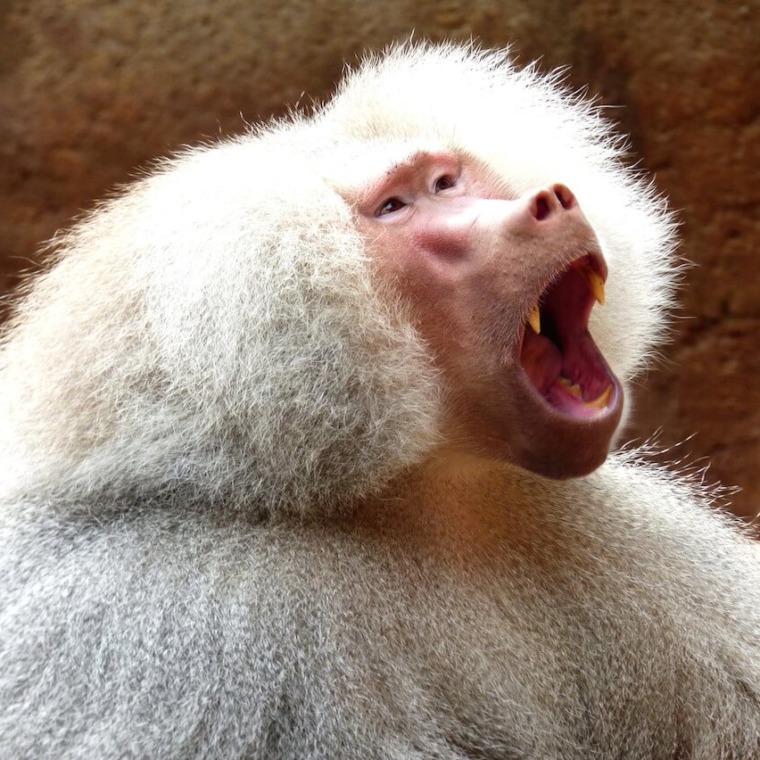
Sacred Baboons are common throughout northeastern Africa, but are extinct in the Nile region and Egypt, where they originally received their name and were worshiped by the ancient Egyptians.
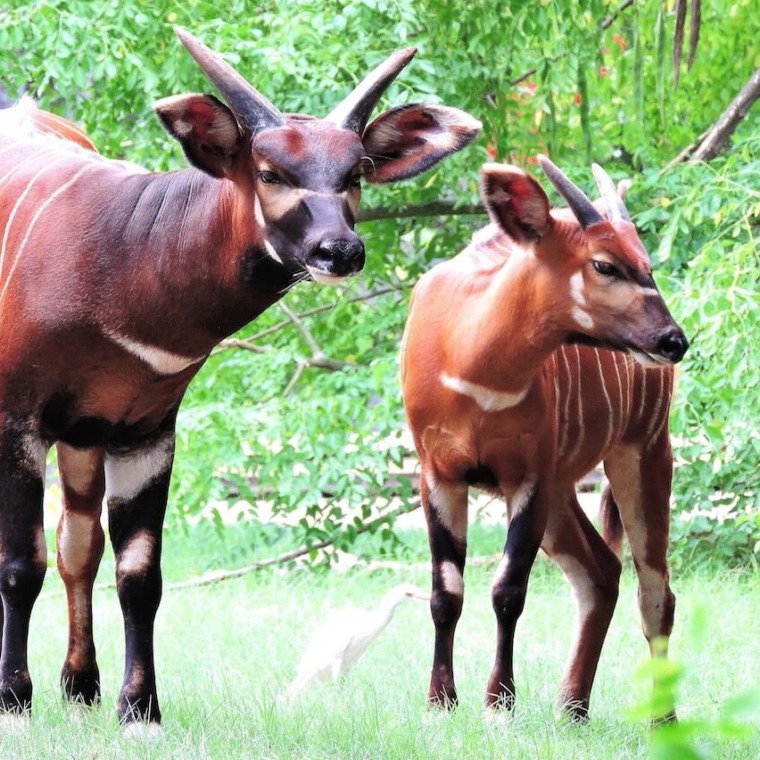
Bongo are most active at dawn and dusk, and often forage near the edges of wooded areas. They normally shy in the wild and flee into the forest for cover at the slightest provocation.
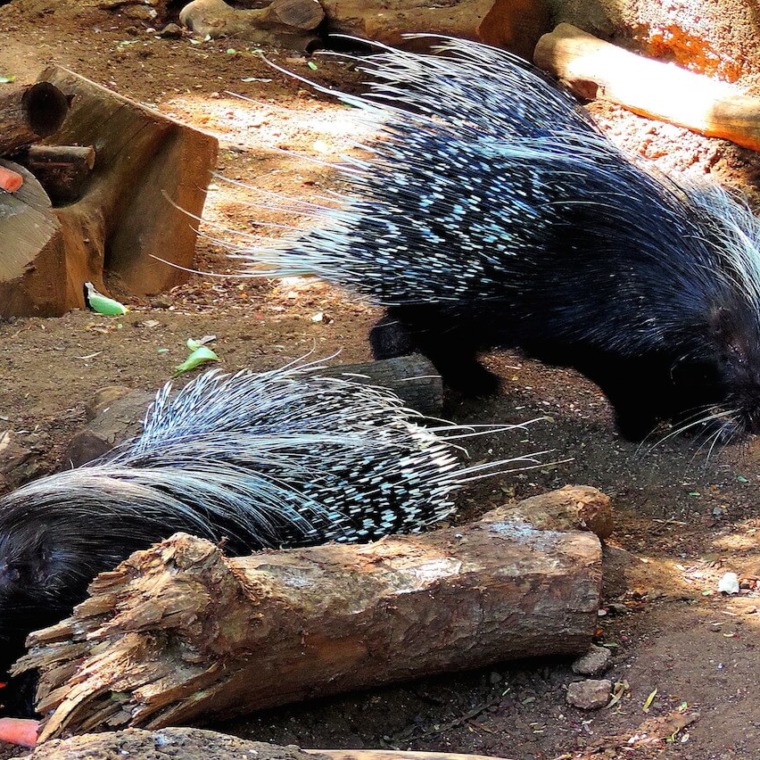
The North African crested porcupine is nocturnal. They are very adaptable and can be found in forests, on plantations, in rocky or mountainous areas as well as in deserts.
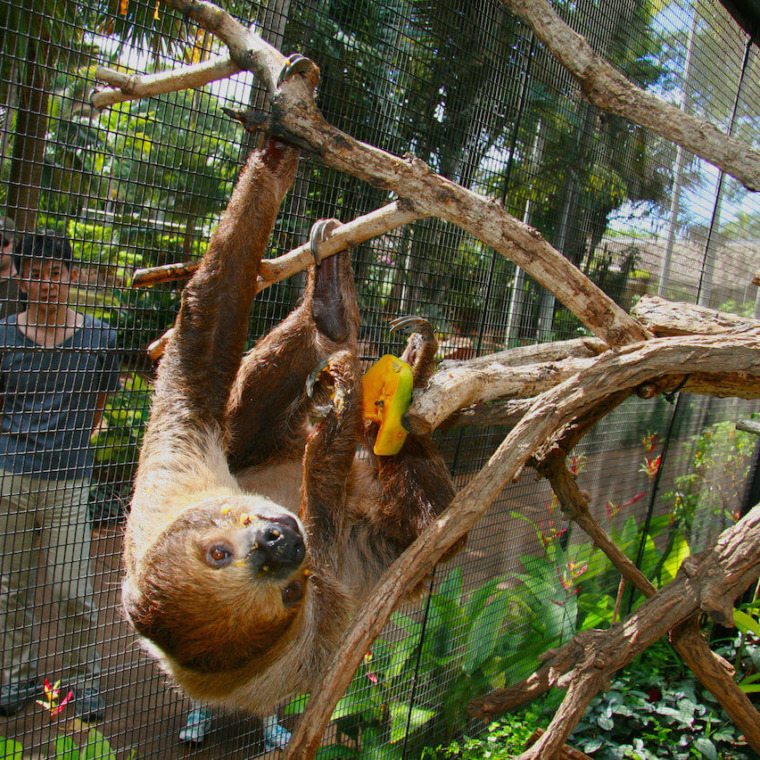
Sloths are found in Central and South America in the rain forest canopy. The Linne’s two-toed sloth is found in such countries as Nicaragua, Columbia, Venezuela, Surinam, Guyana, French Guiana, North Central Brazil, and Northern Peru.
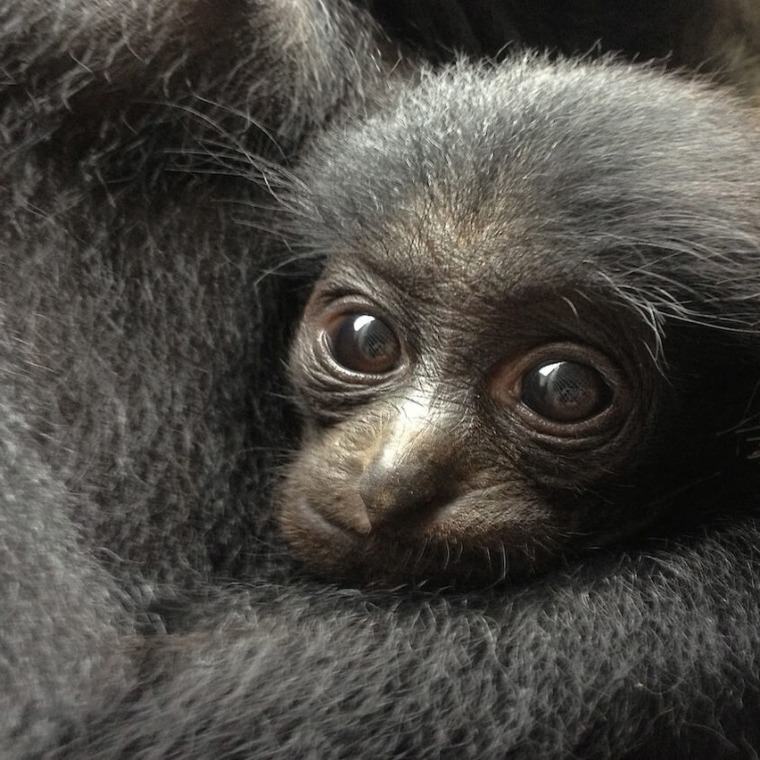
Siamangs range through southeastern Asia and are found in some numbers in the Malay Peninsula and Sumatra.


